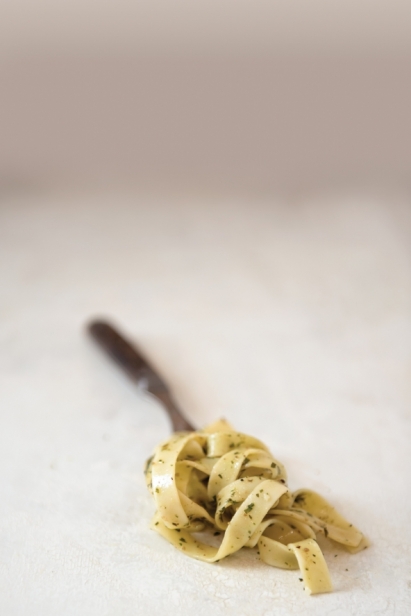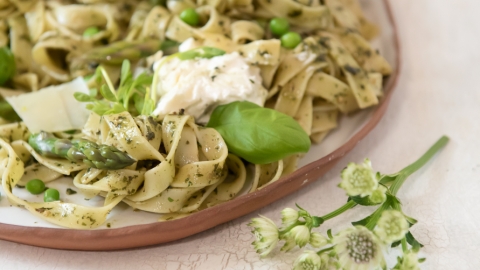Stinging Nettle Pesto
Springtime is always exciting to me, with opening skies, buds coming to life, birds returning from their winter retreat and a whole new season of fresh greens from the earth. If you want to eat local, seasonal and organic, stinging nettles are an excellent way to ring in your spring. Carefully harvested and prepared, they are a wonderful seasonal ingredient, lending a fresh, spinach-like taste to a variety of dishes.
Originally a Eurasian plant, stinging nettles (Urtica dioica) are now found throughout the world and are abundant on Vancouver Island. Look for it at trail edges, near ponds, and in open meadows where there has been some rainfall and a splash of sun.
Harvesting
Nettle stalks grow up to three metres high, though they are best early in the season when they have the most favourable texture and flavor. They grow in large crops, so harvesting a bundle isn’t too difficult. I get mine on my family’s property on Quadra Island, but they can also be found at local farm markets.
In my experience, every year around Easter is a great time for harvesting buckets of stinging nettles. Use gloves—trust me—as the tiny hollow ‘needles’ on the underside of the leaves are not forgiving and you will feel that sting for several hours if you happen to touch them. Wear gloves, bring scissors and gather as much as you can.
Preparing
Like spinach and similar greens, nettles shrink significantly with the application of heat—a necessary step to remove the sting. The jagged, toothy leaves grow on opposite sides of the stem. You want to look for leaves that are 4-10 cm long, free of bug infestation and not in a zone where they are exposed to exhaust or chemicals. (This may sound similar to many plants you find here on the island, so adopt the forager’s rule and refrain from eating anything you harvest yourself unless you can identify it with complete certainty.)
Once your nettles are home, soak them in cold water for half an hour or so to clean them, remove any thick stems (remember your gloves) and give them a short steam, about 30 seconds to one minute. Using tongs, place them in an ice bath to stop them from cooking any further. Squeeze out any excess water, and they’re ready to use. If I have an over-abundance, I’ll blitz them a little in a food processor and put them in the freezer in small containers or ice cube trays to pop into soups or stews later.
How to Enjoy Them
After steaming, you can wrap the leaves around chicken tenders before baking, or use them to make nettle soup (no need to pre-steam as the heat of the soup will effectively remove the sting). You can also make gomae (the Japanese word for sesame dressing and a dish typically made with spinach) and enjoy tea, simply by steeping stems and leaves. Make pesto (see recipe below). Nettle leaves are a bit small for stuffing, but you can do a lazy version of dolmades by layering them with rice, pine nuts, currants, lemon, dill and ground lamb in a pan, placing a heavy weight on top and baking. When you steam them, be sure to save and drink the juice or put it in your smoothie—nettles are chock-full of vitamins A C, D, iron and calcium and the juice is not at all bitter.







